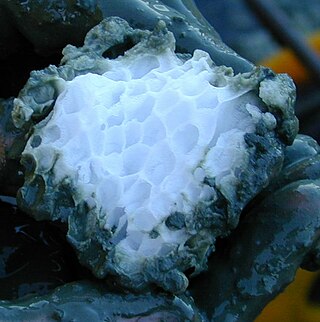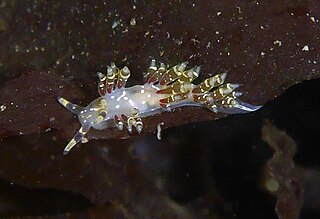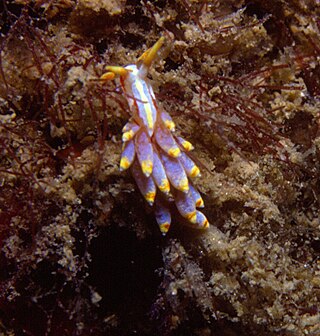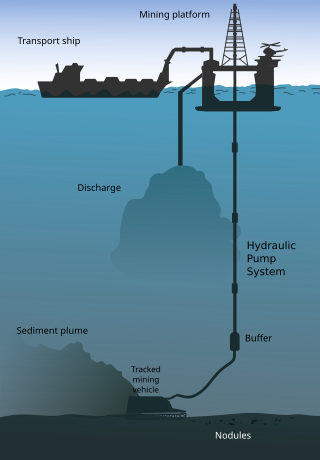
Methane clathrate (CH4·5.75H2O) or (4CH4·23H2O), also called methane hydrate, hydromethane, methane ice, fire ice, natural gas hydrate, or gas hydrate, is a solid clathrate compound (more specifically, a clathrate hydrate) in which a large amount of methane is trapped within a crystal structure of water, forming a solid similar to ice. Originally thought to occur only in the outer regions of the Solar System, where temperatures are low and water ice is common, significant deposits of methane clathrate have been found under sediments on the ocean floors of the Earth (approx. 1100m below the sea level). Methane hydrate is formed when hydrogen-bonded water and methane gas come into contact at high pressures and low temperatures in oceans.

Clathrate hydrates, or gas hydrates, clathrates, or hydrates, are crystalline water-based solids physically resembling ice, in which small non-polar molecules or polar molecules with large hydrophobic moieties are trapped inside "cages" of hydrogen bonded, frozen water molecules. In other words, clathrate hydrates are clathrate compounds in which the host molecule is water and the guest molecule is typically a gas or liquid. Without the support of the trapped molecules, the lattice structure of hydrate clathrates would collapse into conventional ice crystal structure or liquid water. Most low molecular weight gases, including O2, H2, N2, CO2, CH4, H2S, Ar, Kr, and Xe, as well as some higher hydrocarbons and freons, will form hydrates at suitable temperatures and pressures. Clathrate hydrates are not officially chemical compounds, as the enclathrated guest molecules are never bonded to the lattice. The formation and decomposition of clathrate hydrates are first order phase transitions, not chemical reactions. Their detailed formation and decomposition mechanisms on a molecular level are still not well understood. Clathrate hydrates were first documented in 1810 by Sir Humphry Davy who found that water was a primary component of what was earlier thought to be solidified chlorine.

A cold seep is an area of the ocean floor where seepage of fluids rich in hydrogen sulfide, methane, and other hydrocarbons occurs, often in the form of a brine pool. Cold does not mean that the temperature of the seepage is lower than that of the surrounding sea water; on the contrary, its temperature is often slightly higher. The "cold" is relative to the very warm conditions of a hydrothermal vent. Cold seeps constitute a biome supporting several endemic species.

The clathrate gun hypothesis is a proposed explanation for the periods of rapid warming during the Quaternary. The hypothesis is that changes in fluxes in upper intermediate waters in the ocean caused temperature fluctuations that alternately accumulated and occasionally released methane clathrate on upper continental slopes. This would have had an immediate impact on the global temperature, as methane is a much more powerful greenhouse gas than carbon dioxide. Despite its atmospheric lifetime of around 12 years, methane's global warming potential is 72 times greater than that of carbon dioxide over 20 years, and 25 times over 100 years. It is further proposed that these warming events caused the Bond Cycles and individual interstadial events, such as the Dansgaard–Oeschger interstadials.

The Ocean Observatories Initiative (OOI) is a National Science Foundation (NSF) Major Research Facility composed of a network of science-driven ocean observing platforms and sensors in the Atlantic and Pacific Oceans. This networked infrastructure measures physical, chemical, geological, and biological variables from the seafloor to the sea surface and overlying atmosphere, providing an integrated data collection system on coastal, regional and global scales. OOI's goal is to deliver data and data products for a 25-year-plus time period, enabling a better understanding of ocean environments and critical ocean issues.

The Nankai Trough is a submarine trough located south of the Nankaidō region of Japan's island of Honshu, extending approximately 900 km (559 mi) offshore. The underlying fault, the Nankai megathrust, is the source of the devastating Nankai megathrust earthquakes, while the trough itself is potentially a major source of hydrocarbon fuel, in the form of methane clathrate.

Methane is a chemical compound with the chemical formula CH4. It is a group-14 hydride, the simplest alkane, and the main constituent of natural gas. The abundance of methane on Earth makes it an economically attractive fuel, although capturing and storing it is hard because it is a gas at standard temperature and pressure.
Pockmarks are concave, crater-like depressions on seabeds that are caused by fluids escaping and erupting through the seafloor. They can vary in size and have been found worldwide.
Cuthona is a genus of nudibranch in the family Cuthonidae.

A methane chimney or gas chimney is a rising column of natural gas, mainly methane, within a water or sediment column. The contrast in physical properties between the gas phase and the surrounding water makes such chimneys visible in oceanographic and geophysical data. In some cases, gas bubbles released at the seafloor may dissolve before they reach the ocean surface, but the increased hydrocarbon concentration may still be measured by chemical oceanographic techniques.

Asphalt volcanoes are a rare variety of submarine volcano (seamount). They were unknown before 2003. Several examples have been found along the coasts of the United States and Mexico and elsewhere, some still showing activity. Asphalt volcanoes resemble other seamounts however they are made entirely of asphalt. The structures are thought to form above geologic faults through which petroleum seeps from deeper in the Earth's crust.
Nankai Methane Hydrate Site is located in the Nankai Trough, Japan.

Abronica abronia, common name graceful aeolid, is a species of sea slug, an aeolid nudibranch, a marine gastropod mollusc in the family Abronicidae.

Trinchesia genovae is a species of sea slug, an aeolid nudibranch, a marine gastropod mollusc in the family Trinchesiidae.
Tenellia diminutiva is a species of sea slug, an aeolid nudibranch, a marine gastropod mollusc in the family Fionidae.

Southern Hydrate Ridge, located about 90 km offshore Oregon Coast, is an active methane seeps site located on the southern portion of Hydrate Ridge. It extends 25 km in length and 15 km across, trending north-northeast-south-southwest at the depth of approximately 800 m. Southern Hydrate Ridge has been the site of numerous submersible dives with the human occupied Alvin submarine, extensive visits by numerous robotic vehicles including the Canadian ROV ROPOS, Jason , and Tiburon (MBARI), and time-series geophysical studies that document changes in the subsurface distribution of methane. It is also a key site of the National Science Foundations Regional Cabled Array that is part of the Ocean Observatories Initiative (OOI), which includes eight types of cabled instruments streaming live data back to shore 24/7/365 at the speed of light, as well as uncabled instruments.

NOASS Okeanos Explorer Gulf of Mexico 2017 Expedition was the first of three expeditions on the NOAAS Okeanos Explorer intended to increase the understanding of the deep-sea environment in the Gulf of Mexico. Gulf of Mexico 2017 was a 23-day telepresence-enabled expedition focused on acquiring data on priority exploration areas identified by ocean management and scientific communities. The goal of the expedition was to use remotely operated vehicle (ROV) dives and seafloor mapping operations to increase the understanding of the deep-sea ecosystems in these areas to support management decisions. Many of the areas had no sonar data, these areas were top priority for high-resolution bathymetry collection. The expedition established a baseline of information in the region to catalyze further exploration, research, and management activities. The expedition lasted from 29 November 2017 to 21 December 2017.
Not to be confused with pingo landforms.

Seabed mining, also known as Seafloor mining is the recovery of minerals from the seabed by techniques of underwater mining. The concept includes mining at shallow depths on the continental shelf and deep-sea mining at greater depths associated with tectonic activity, hydrothermal vents and the abyssal plains. The increased requirement for minerals and metals used in the technology sector has led to a renewed interest in the mining of seabed mineral resources, including massive polymetallic sulfide deposits around hydrothermal vents, cobalt-rich crusts on the sides of seamounts and fields of manganese nodules on the abyssal plains. While the seabed provides a high concentration of valuable minerals, there is an unknown risk of ecological damage on marine species because of a lack of data.
Marta E. Torres is a marine geologist known for her work on the geochemistry of cold seeps and methane hydrates. She is a professor at Oregon State University, and an elected fellow of the Geochemical Society and the Geological Society of America.













